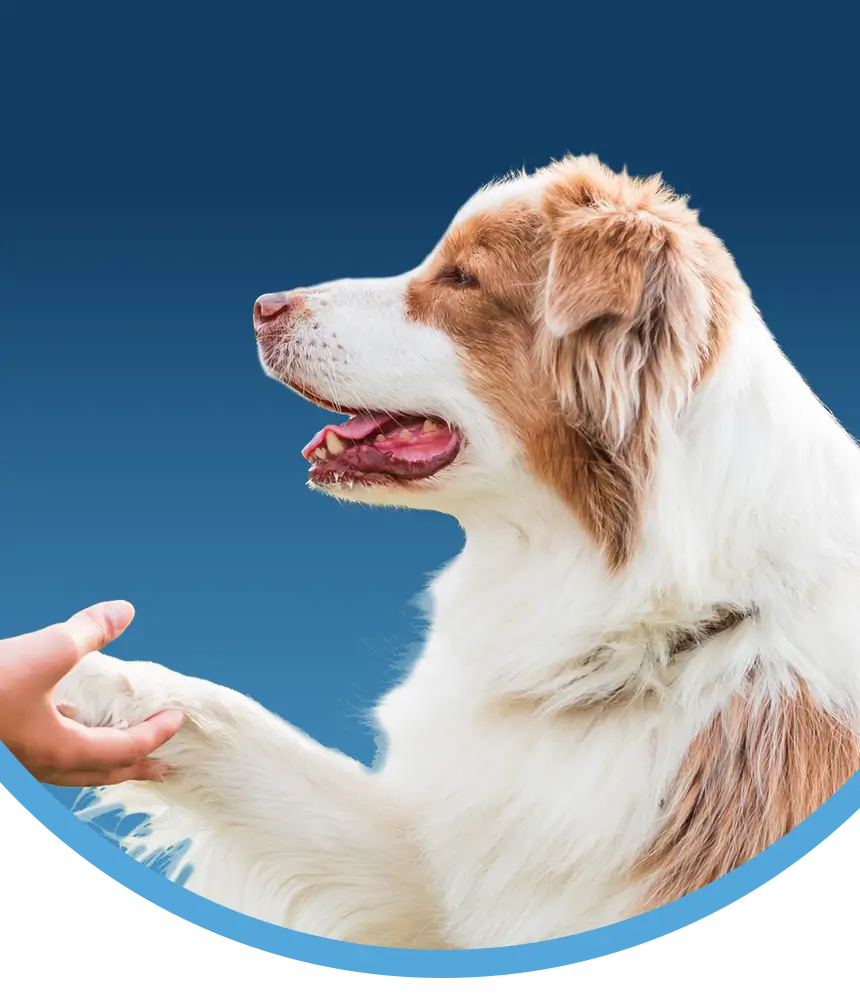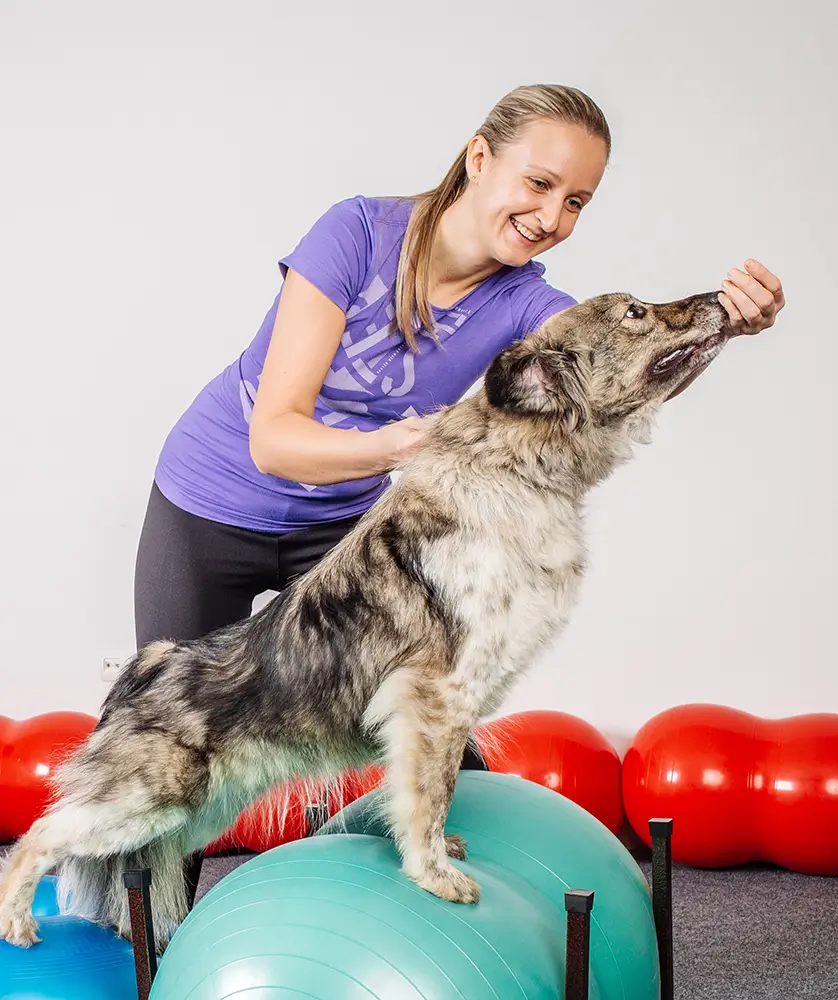Animal Trainer Certification Program
Completing the Fear Free Animal Trainer Program allows trainers to work in partnership with veterinary teams to prevent and alleviate fear, anxiety, and stress and improve an animal’s emotional wellbeing during veterinary care and home care.

Trainer Membership
The Trainer Membership is designed for training professionals that who meet prerequisites that ensure a specific level of knowledge, education, and experience. The certification program included with this membership will equip qualified animal trainers with the knowledge and tools required to begin implementing Fear Free techniques with their clients’ pets at the veterinary hospital, through in-clinic training classes for puppies and kittens, and in day-to-day training of animals in the home.

Course Overview
Trainers who complete the Fear Free Animal Trainer Certification Program will acquire the skills to manage and handle dogs and cats alongside the veterinary team during veterinary visits and care to ease the pet’s apprehension regarding exams, procedures, and other care. The techniques may also be used in a home setting for carrying out or administering specific veterinarian-prescribed care plans or routine care like grooming. Most important, Fear Free Certified Trainers are equipped to prepare pets for what to expect at the veterinary clinic, so they have an enjoyable, stress-free experience.
Course author: Mikkel Becker, CBCC-KA, CPDT-KA, KPA CTP, CDBC, CTC
This course is approved through the following organizations:
- 10 hours of CCPDT CEUs
- 10 hours of IAABC CEUs
- 10 hours of KPA CEUs
- 10 hours of RACE CE
Lesson 1: The Fear Free Mission and Meaning
By the end of this lesson, you will be able to:
- Recognize the barriers to care caused by fear, anxiety and stress (FAS)
- Identify how Fear Free’s commitment to preventing and alleviating FAS makes a difference in animals receiving quality veterinary healthcare
- Define fear, anxiety, stress and stressors as used for Fear Free purposes
- Recognize both the immediate and long-term effects of FAS on the animal’s body and health
Lesson 2: The Trainer’s Role and Goals in Fear Free
By the end of this lesson, you will be able to:
- Note the strategies and skills of the Fear Free Animal Trainer and how these enhance comfort with veterinary care
- Identify the potential partnered efforts between the trainer, pet owner and veterinary team and potential services to offer as Fear Free Animal Trainer
Lesson 3: Managing Fear, Anxiety, and Stress (FAS) as a Team
By the end of this lesson, you will be able to:
- Recognize the importance of teaching others the signs of animal communication as gauged through body language
- Identify body language that’s indicative of fear, anxiety and stress (FAS)
- Recognize signs of happy, relaxed body language in dogs and cats
- Identify key signs of FAS in the eyes, ears, mouth, tail
- Tune into specific signs within the context of the animal’s overall body language
- Recognize and identify the behavior responses to fear, anxiety and stress (FAS): the four F’s; fidget/fret, freeze, flight and fight
Lesson 4: Teachable Moments for Calmer Behavior and Care
By the end of this lesson, you will be able to:
- Explain how pairing positives is an essential aspect of Fear Free veterinary visits
- Identify when and why distractions might be used
- Note the limitations of distractions
- Note how classical conditioning, classical counter conditioning and desensitization are powerful for increasing calm reactions to care
Lesson 5: Introduction to Fear Free Core Concepts
By the end of this lesson, you will have gained an understanding and application of the following Fear Free Concepts:
- The FAS Scale
- Considerate approach
- Gentle control
- Touch gradient
Lesson 1: Home to Hospital: Set the Stage for More Relaxed Care
By the end of this lesson, you will be able to:
- Build strategies to prep pets prior to the veterinary visit
- Provide calmer carrier training tips for cats
- Apply protocols to improve car travel for dogs and cats
Lesson 2: Serene Scene
By the end of this lesson, you will be able to:
- Recognize how to transfer patients calmly from the car into the hospital and into the exam room
- Set up the lobby and exam room in a manner that’s sensitive to patient needs
Lesson 3: Gentle Control for Better Veterinary Care
By the end of this lesson, you will be able to:
- Apply the rules of restraint/stabilization
- Incorporate touch gradient into handling
- Differentiate between ‘wants’ vs. ‘needs’ in care
Lesson 4: Fear Free Planning and Modification
By the end of this lesson, you will be able to:
- State the common tools that may be used for gentle control
- Utilize training concepts to condition animals to gentle control tools
Lesson 5: Proactive Efforts to Acclimate to the Veterinary Environment and Integration of Training Into Veterinary Care
By the end of this lesson, you will be able to:
- State ways to improve the value of fun visits
- Improve client participation with fun visits
- Implement structured stations into fun visits
Lesson 1: Socialization Classes in the Hospital and Integration of Veterinary Prep Into the Curriculum
By the end of this lesson, you will be able to:
- State the age window for animal participants in kitten and puppy classes
- Identify common problem prevention topics to discuss with kitten and puppy owners
- Incorporate handling and equipment conditioning exercises into early socialization classes
Lesson 2: Positive Familiarity With Equipment and Tools
By the end of this lesson, you will be able to:
- State the importance of an animal’s choice to interact with equipment or to move away if uncomfortable
- Describe principles for conditioning a dog to willingly wear a muzzle
- Apply concepts of desensitization and counter conditioning to teach a cat to willingly accept and enjoy being draped in a towel
Lesson 3: Calmer Care Conditioning for the Veterinary Visit
By the end of this lesson, you will be able to:
- State ways to incorporate elements of gentle control when conditioning animals to handling
- Describe how negative reinforcement may be utilized during calmer care conditioning
Lesson 4: Communication Cues
By the end of this lesson, you will be able to:
- Explain the use of communication cues
- State situations where communication cues may be helpful
- Clarify when communication cues should be added
Lesson 1: Pet Positioning That’s Right on Target
By the end of this lesson, you will be able to:
- Describe ways cooperative care can help during vet visits
- State how target training can be used during care
Lesson 2: Voluntary Interaction With Equipment and Tools
By the end of this lesson, you will be able to:
- Employ ‘touch’ or ‘check’ training with equipment
- Shape a dog to wear a muzzle or Elizabethan collar
- Incorporate treats that are easy to deliver into muzzle training
Lesson 3: Pet Participation Stations and Permission for Care
By the end of this lesson, you will be able to:
- Describe ‘I’m ready behaviors’ you could use with clients to improve their ability to assess emotional well-being during care
- Incorporate “I’m ready” stationing positions into introductions and handling with the veterinary team
Lesson 1: Duration Stationing During Care
By the end of this lesson, you will be able to:
- Identify some possible duration stationing behaviors for care
- Recognize the need to use successive approximations to incorporate elements of care into the duration behavior
Lesson 2: Active Pet Participation
By the end of this lesson, you will be able to:
- Describe the differences between passive and active cooperative care behaviors
- Identify active participation behaviors you could employ in care
Lesson 3: Trained Behaviors Application During Veterinary Care
By the end of this lesson, you will be able to:
- State specific behaviors that may be used during veterinary care
- List places where conditioning and cooperative behaviors may be utilized during care
Lesson 1: Calmer Home Care and Implementation and Administration of Specific Veterinary Prescribed Care Plans
By the end of this lesson, you will be able to:
- Collaborate with the veterinary team and coordinate with the pet owner to help implement and administer veterinary prescribed in-home care plans
- Recognize how to apply follow-up care in the home, including use of equipment and administration of medication using principles learned previously during the course
Lesson 2: Collaboration With the Veterinarian
By the end of this lesson, you will be able to:
- State the ethical commitments of the Fear Free Animal Trainer in protecting the emotional well-being of animals during training and other services
- Outline ethical boundaries of the Fear Free Animal Trainer and reasons for referral to a veterinarian and/or veterinary behaviorist
- Recognize the importance of a history and training report for referral and collaboration with a veterinary team on a behavior issue
Lesson 3: Working Together With the Veterinary Team
By the end of this lesson, you will be able to:
- Explain pressures commonly faced in veterinary medicine that are important for the trainer to consider in partnership with the team
- Describe ways the trainer can encourage Fear Free strategies among veterinary team members

Member Benefits
Discover the exclusive benefits included with the Trainer Membership. In addition to the applicable certification program, your membership gives you access to so much more!
Additional Courses
Deepen your Fear Free knowledge and earn more CE. Explore all courses here.
Marketing Resources
Download logos, email signatures, social media graphics, and more!
Educational Resources
Peruse client communication handouts, fear, anxiety and stress assets, questionnaires, and more!
Directory Listing
Once individually certified, members have the opportunity to opt-in to be found in our online directory. Find a Fear Free certified professional or practice near you.
Certification Kit
Once individually certified, members are able to order a complimentary gift to celebrate their new certification.
Facebook Community
Join our exclusive, members-only Facebook group to share advice and connect with other Fear Free professionals.
Product Discounts
Enjoy special pricing on products and services that are aligned with our values. View Friends of Fear Free.
Merchandise & Swag
Our online store is exclusive to active members who can purchase merch and swag to promote certification status.
Eligibility
The Fear Free Animal Trainer Certification Program is open to training professionals who meet prerequisites that ensure a specific level of knowledge, education, and experience. Trainers seeking this certification are highly encouraged to have experience working in a veterinary hospital/practice setting. Eligible trainers will meet the following prerequisites:
- Passing score (80% or better) on the entrance exam that tests baseline knowledge
- Current certification with an approved organization and/or proof of completing an approved continuing education course from at least one of the following:
View approved organizations
- American College of Veterinary Behaviorists Diplomate (DACVB)
- APPVOC (Applied Vocational Training)
- Associate Certified Applied Animal Behaviorist (ACAAB)
- Canine Training Technician (Accredited) (CTT-A)
- Certified Behavior Consultant through IAABC (Certified Behavior Consultant Certified in the Dog, Cat, Horse or Avian Species or Certified Shelter Behavior Professional
- Certified Behavior Counselor Canine (CBCC-KA)
- Certified Professional Dog Trainer (CPDT-KA or CPDT-KSA)
- Certified Applied Animal Behaviorist (CAAB)
- Dogma Certified Behavior Consultant (DCBC)
- How Behavior Works: Living and Learning with Animals (Dr. Susan Friedman)
- Member of American Veterinary Society of Animal Behavior (AVSAB)
- Professional Canine Behavior Consultant (Accredited) (PCBC-A) through the Pet Professional Accreditation Board
- Professional Canine Trainer (Accredited) (PCT-A)
- Professional Development Diploma in Canine Behavior Analysis and Counseling through the American College of Applied Science
- International trainers: If the organization you are certified/accredited with teaches the principles of ethical, humane, positive reinforcement training, such as the organizations listed here, proceed to register. Enter your organization under the bullet “other” listed in question one of the pre-requisite quiz. Fear Free will conduct research on the organization you listed, and if it does not teach the principles of ethical, humane, positive reinforcement training, we reserve the right to cancel your membership without refunding your fee.
Requirements
To successfully attain and maintain certification, all members must:
- Pass each online module with a score of 80% or higher.
- Sign and uphold to the Fear Free Pledge, a commitment to follow a humane, emotionally protective code of conduct and ethical standards.
- Keep an active membership.
Pet Professional Membership Pricing
This category of memberships are renewed annually from the date of purchase or date of membership assignment by a Team Administrator. All pricing is in USD. Memberships available within Pet Professional memberships include trainer, groomer, pet sitter, and boarding & daycare individuals. These memberships function independently and cannot be combined.
Number of Members
Annual Renewal
Member Pricing*
Individuals with an existing, active Fear Free membership can purchase any additional pet professional membership for $119. This special member pricing is only available to memberships within the pet professional membership category.